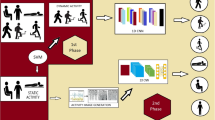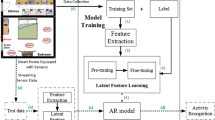Abstract
With the evolution of smart devices like smartphones, smartwatches, and other wearable devices, motion sensors have been integrated into these devices to collect data and analyze human activities. Consequently, sensor-based Human Activity Recognition (HAR) has emerged as a significant research area in the fields of ubiquitous computing and wearable computing. This paper presents a novel approach that employs Latent Dirichlet Allocation (LDA) to extract meaningful representations from activity signals. The method involves transforming the activity signal, which is a sequence of samples, into a sequence of discrete symbols using vector quantization. Subsequently, LDA is utilized to embed the symbol sequence into a fixed-length representation vector. Finally, a classifier is employed to classify the obtained representation vector. The effectiveness of the proposed method is evaluated using the UNIMIB-SHAR dataset. Experimental results demonstrate its competitive performance in terms of accuracy and F1-score metrics when compared to existing methods. Moreover, our method boasts a more lightweight architecture and incurs lower computational costs compared to deep learning-based approaches. The findings of this study contribute to the advancement of HAR and hold practical implications for HAR systems.





Similar content being viewed by others
Data availability and materials
The dataset analyzed during the current study is from public resources.
References
Bulling, A., Blanke, U., Schiele, B.: A tutorial on human activity recognition using body-worn inertial sensors. ACM Comput. Surveys (CSUR) 46(3), 1–33 (2014)
Demrozi, F., Pravadelli, G., Bihorac, A., Rashidi, P.: Human activity recognition using inertial, physiological and environmental sensors: a comprehensive survey. IEEE Access 8, 210816–210836 (2020)
Lara, O.D., Labrador, M.A.: A survey on human activity recognition using wearable sensors. IEEE Commun. Surveys Tutor. 15(3), 1192–1209 (2012)
Kamminga, J.W., Le, D.V., Havinga, P.J.M.: Towards deep unsupervised representation learning from accelerometer time series for animal activity recognition. In: Proceedings of the 6th Workshop on Mining and Learning from Time Series, MiLeTS (2020)
Jain, Y., Tang, C.I., Min, C., Kawsar, F., Mathur, A.: Collossl: collaborative self-supervised learning for human activity recognition. Proc. ACM Interact. Mobile Wear. Ubiq. Technol. 6(1), 1–28 (2022)
Paysan, D., Haug, L., Bajka, M., Oelhafen, M., Buhmann, J.M.: Self-supervised representation learning for surgical activity recognition. Int. J. Comput. Assist. Radiol. Surg. 16, 2037–2044 (2021)
Cheng, X., Zhang, L., Tang, Y., Liu, Y., Hao, W., He, J.: Real-time human activity recognition using conditionally parametrized convolutions on mobile and wearable devices. IEEE Sens. J. 22(6), 5889–5901 (2022)
Zhang, S., Li, Y., Zhang, S., Shahabi, F., **a, S., Deng, Y., Alshurafa, N.: Deep learning in human activity recognition with wearable sensors: a review on advances. Sensors 22(4), 1476 (2022)
Blei, D.M., Ng, A.Y., Jordan, M.I.: Latent Dirichlet allocation. J. Mach. Learn. Res. 3(Jan), 993–1022 (2003)
Micucci, D., Mobilio, M., Napoletano, P.: Unimib shar: a dataset for human activity recognition using acceleration data from smartphones. Appl. Sci. 7(10), 1101 (2017)
Ravi, N., Dandekar, N., Mysore, P., Littman, M.L.: Activity recognition from accelerometer data. In: AAAI, vol 5, pp 1541–1546. Pittsburgh, PA (2005)
Chen, L., Hoey, J., Nugent, C.D., Cook, D.J., Zhiwen, Yu.: Sensor-based activity recognition. IEEE Trans. Syst. Man Cybern. Part C (Appl. Rev.) 42(6), 790–808 (2012)
Chen, K., Zhang, D., Yao, L., Guo, B., Zhiwen, Yu., Liu, Y.: Deep learning for sensor-based human activity recognition: overview, challenges, and opportunities. ACM Comput. Surveys (CSUR) 54(4), 1–40 (2021)
Wang, J., Chen, Y., Hao, S., Peng, X., Lisha, H.: Deep learning for sensor-based activity recognition: a survey. Pattern Recogn. Lett. 119, 3–11 (2019)
Kwapisz, J.R., Weiss, G.M., Moore, S.A.: Activity recognition using cell phone accelerometers. ACM SIGKDD Explor. Newsl. 12(2), 74–82 (2011)
Anguita, D., Ghio, A., Oneto, L., Parra, X., Reyes-Ortiz, J.L.: Human activity recognition on smartphones using a multiclass hardware-friendly support vector machine. In: Ambient Assisted Living and Home Care: 4th International Workshop, IWAAL 2012, Vitoria-Gasteiz, Spain, December 3-5, 2012. Proceedings 4, pages 216–223. Springer (2012)
Reyes-Ortiz, J.-L., Oneto, L., Samà, A., Parra, X., Anguita, D.: Transition-aware human activity recognition using smartphones. Neurocomputing 171, 754–767 (2016)
Uddin, M.T., Billah, M.M., Hossain, M.F.: Random forests based recognition of human activities and postural transitions on smartphone. In: 2016 5th International Conference on Informatics, Electronics and Vision (ICIEV), pages 250–255. IEEE (2016)
Noor, M.H.M., Salcic, Z., Kevin, I., Wang, K.: Adaptive sliding window segmentation for physical activity recognition using a single tri-axial accelerometer. Pervasive Mobile Comput. 38, 41–59 (2017)
Gupta, P., Dallas, T.: Feature selection and activity recognition system using a single triaxial accelerometer. IEEE Trans. Biomed. Eng. 61(6), 1780–1786 (2014)
Shirahama, K., Kö**, L., Grzegorzek, M.: Codebook approach for sensor-based human activity recognition. In: Proceedings of the 2016 ACM International Joint Conference on Pervasive and Ubiquitous Computing: Adjunct, pages 197–200 (2016)
Picard, R.W., Vyzas, E., Healey, J.: Toward machine emotional intelligence: analysis of affective physiological state. IEEE Trans. Pattern Anal. Mach. Intell. 23(10), 1175–1191 (2001)
Ofli, F., Chaudhry, R., Kurillo, G., Vidal, R., Bajcsy, R.: Berkeley MHAD: a comprehensive multimodal human action database. In: 2013 IEEE Workshop on Applications of Computer Vision (WACV), pages 53–60. IEEE (2013)
Yang, J., Nguyen, M.N., San, P.P., Li, X., Krishnaswamy, S.: Deep convolutional neural networks on multichannel time series for human activity recognition. In: IJCAI. vol 15, pp. 3995–4001. Buenos Aires, Argentina (2015)
Ordóñez, F.J., Roggen, D.: Deep convolutional and LSTM recurrent neural networks for multimodal wearable activity recognition. Sensors 16(1), 115 (2016)
Hammerla, N.Y., Halloran, S., Plötz, T.: Deep, convolutional, and recurrent models for human activity recognition using wearables. ar**v Preprintar**v:1604.08880, (2016)
Guan, Yu., Plötz, T.: Ensembles of deep LSTM learners for activity recognition using wearables. Proc. ACM Interact. Mobile Wear. Ubiq. Technol. 1(2), 1–28 (2017)
Murahari, V.S., Plötz, T.: On attention models for human activity recognition. In: Proceedings of the 2018 ACM International Symposium on Wearable Computers, pages 100–103 (2018)
Qian, H., Pan, S.J., Da, B., Miao, C.: A novel distribution-embedded neural network for sensor-based activity recognition. In: IJCAI, vol 2019, pages 5614–5620 (2019)
Bock, M., Hölzemann, A., Moeller, M., Van Laerhoven, K.: Improving deep learning for HAR with shallow LSTMS. In: 2021 International Symposium on Wearable Computers, pages 7–12 (2021)
Shuai Shao, Yu., Guan, B.Z., Missier, P., Plötz, T.: Convboost: boosting convnets for sensor-based activity recognition. Proc. ACM Interact. Mobile Wear. Ubiq. Technol. 7(2), 1–21 (2023)
Rong, H., Chen, L., Miao, S., Tang, X.: Swl-adapt: an unsupervised domain adaptation model with sample weight learning for cross-user wearable human activity recognition. Proc. AAAI Conf. Artif. Intell. 37, 6012–6020 (2023)
Sannara E.K., Portet, F., Lalanda, P.: Lightweight transformers for human activity recognition on mobile devices. ar**v preprintar**v:2209.11750 (2022)
Gersho, A., Gray, R.M.: Vector Quantization and Signal Compression, vol. 159. Springer Science & Business Media, Dordrecht (2012)
Lai, J.Z.C., Liaw, Y.-C., Liu, J.: A fast VQ codebook generation algorithm using codeword displacement. Pattern Recogn. 41(1), 315–319 (2008)
Hsieh, C.-H., Tsai, J.-C.: Lossless compression of VQ index with search-order coding. IEEE Trans. Image Process. 5(11), 1579–1582 (1996)
Ordóñez, F.J., Roggen, D.: Deep convolutional and LSTM recurrent neural networks for multimodal wearable activity recognition. Sensors 16(1), 115 (2016)
Jelodar, H., Wang, Y., Yuan, C., Feng, X., Jiang, X., Li, Y., Zhao, L.: Latent Dirichlet Allocation (LDA) and topic modeling: models, applications, a survey. Multimedia Tools Appl. 78, 15169–15211 (2019)
Tang, Y., Teng, Q., Zhang, L., Min, F., He, J.: Layer-wise training convolutional neural networks with smaller filters for human activity recognition using wearable sensors. IEEE Sens. J. 21(1), 581–592 (2020)
Gao, W., Zhang, L., Teng, Q., He, J., Hao, W.: DanHAR: dual attention network for multimodal human activity recognition using wearable sensors. Appl. Soft Comput. 111, 107728 (2021)
Tang, Y., Zhang, L., Teng, Q., Min, F., Song, A.: Triple cross-domain attention on human activity recognition using wearable sensors. IEEE Trans. Emerg. Topics Comput. Intell. 6(5), 1167–1176 (2022)
Huang, W., Zhang, L., Wang, S., Hao, W., Song, A.: Deep ensemble learning for human activity recognition using wearable sensors via filter activation. ACM Trans. Embed. Comput. Syst. 22(1), 1–23 (2022)
Li, Y., Yin, R., Park, H., Kim, Y., Panda, P: Wearable-based human activity recognition with spatio-temporal spiking neural networks. ar**v preprintar**v:2212.02233 (2022)
Tang, Y., Zhang, L., Min, F., He, J.: Multiscale deep feature learning for human activity recognition using wearable sensors. IEEE Trans. Ind. Electron. 70(2), 2106–2116 (2022)
Funding
The authors declare that no funds, grants, or other support were received during the preparation of this manuscript.
Author information
Authors and Affiliations
Contributions
All three authors made nearly identical contributions to every aspect of the manuscript.
Corresponding author
Ethics declarations
Conflict of interest
The authors have no relevant financial or non-financial interests to disclose.
Ethics approval
Not applicable.
Additional information
Publisher's Note
Springer Nature remains neutral with regard to jurisdictional claims in published maps and institutional affiliations.
Rights and permissions
Springer Nature or its licensor (e.g. a society or other partner) holds exclusive rights to this article under a publishing agreement with the author(s) or other rightsholder(s); author self-archiving of the accepted manuscript version of this article is solely governed by the terms of such publishing agreement and applicable law.
About this article
Cite this article
Abdi, M.F., BabaAli, B. & Momeni, S. An unsupervised statistical representation learning method for human activity recognition. SIViP (2024). https://doi.org/10.1007/s11760-024-03374-z
Received:
Revised:
Accepted:
Published:
DOI: https://doi.org/10.1007/s11760-024-03374-z




